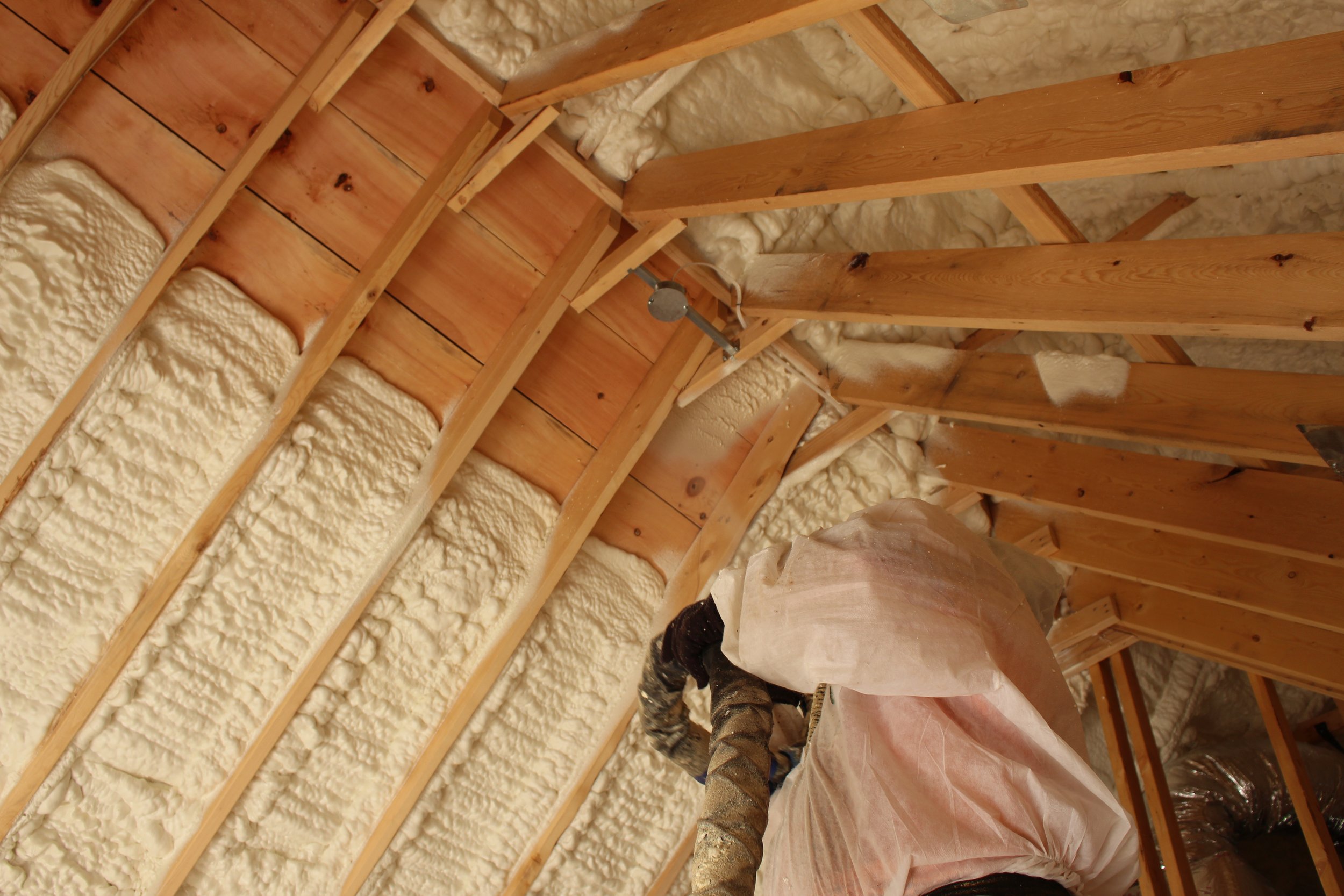Typical Myths Concerning Spray Foam: Debunking the Misconceptions
Typical Myths Concerning Spray Foam: Debunking the Misconceptions
Blog Article
Spray Foam: The Ultimate Remedy for Air Sealing and Insulation
Spray foam insulation has become a leading remedy for reliable air securing and thermal insulation, offering a distinct mix of residential properties that set it apart from conventional approaches. Its ability to broaden and load voids makes it specifically efficient in protecting against air leak, which can substantially affect power effectiveness. Comprehending the full scope of its benefits, installation processes, and comparisons with various other insulation kinds is critical for making educated choices. As we discover these aspects, the implications for both brand-new constructions and retrofits become significantly substantial. What aspects should influence your option?
What Is Spray Foam?
Spray foam is a functional insulation product that combines the concepts of air securing and thermal resistance to boost energy effectiveness in buildings. Made up primarily of polyurethane or various other comparable substances, spray foam is used as a liquid that expands upon call with surfaces, producing a solid, continual layer of insulation. This unique building allows it to fill up spaces, cracks, and gaps that standard insulation materials may ignore, providing a remarkable air seal.
There are two primary sorts of spray foam: open-cell and closed-cell. Open-cell spray foam is lighter and more flexible, offering outstanding noise absorption and a reduced R-value per inch - Spray Foam. On the other hand, closed-cell spray foam is denser, supplying a greater R-value, wetness resistance, and added architectural integrity to developing elements
The application process normally involves customized equipment, guaranteeing a seamless application that abides by different substratums, including steel, timber, and concrete. This adaptability makes spray foam ideal for both brand-new buildings and retrofitting existing frameworks. Its ability to create a closed barrier significantly adds to lowering power consumption and boosting interior air high quality, consequently making it a recommended selection among contractors and property owners alike.
Benefits of Spray Foam Insulation
Among one of the most significant benefits of spray foam insulation is its exceptional capacity to develop a continuous air obstacle, which efficiently minimizes energy loss. Unlike typical insulation materials, spray foam expands to fill splits and spaces, guaranteeing that air leakage is significantly minimized. This characteristic not just improves power performance however also brings about lower energy expenses gradually.
Furthermore, spray foam insulation offers superior thermal resistance, adding to a much more steady interior environment. Its high R-value per inch permits reliable insulation in restricted spaces, making it suitable for attic rooms, wall surfaces, and crawl spaces. The moisture-resistant properties of spray foam assistance prevent mold and mold development, advertising healthier living problems.
An additional vital benefit of spray foam insulation is its sound-dampening high qualities (Spray Foam). It efficiently reduces sound transmission between rooms, creating a quieter and extra comfy home setting. The resilience of spray foam also stands out, as it does not droop or resolve with time, keeping its performance throughout its lifespan
Exactly How Spray Foam Works
Recognizing how spray foam insulation functions is essential for valuing its efficiency in air sealing and thermal resistance. Spray foam insulation includes two key elements: isocyanate and polyol resin. When these components are blended, they go through a chemical response that causes the product to broaden rapidly, producing a thick foam that fills up voids, tooth cavities, and fractures.
As the foam increases, it adheres to surfaces, creating an impermeable seal that substantially reduces air infiltration. This particular makes spray foam insulation highly effective at protecting against drafts and moisture infiltration, which index can cause energy loss and damage with time. Furthermore, the closed-cell version of spray foam offers remarkable thermal resistance because of its stiff framework, effectively lessening heat transfer.
The unique homes of spray foam permit it to adapt irregular surface Going Here areas, guaranteeing comprehensive insurance coverage and a smooth obstacle. Therefore, spray foam insulation not just improves energy efficiency however also adds to boosted indoor air high quality by lowering the accumulation of toxins and irritants. Ultimately, understanding the mechanics behind spray foam highlights its role as a superior option for insulation and air securing in both business and household applications.
Installation Refine Overview

Prior to setup, the area must be effectively cleaned up and prepped, ensuring that surface areas are without particles, dampness, and dust. This step is vital due to the fact that pollutants can jeopardize bond and overall performance. When the area is prepared, the application includes mixing both elements of the spray foam, which expands upon get in touch with and fills up spaces effectively.
Trained specialists must perform the setup, using customized equipment to guarantee uniform coverage and ideal thickness. Safety preventative measures, including using safety equipment and ensuring proper ventilation, are imperative during this process. After application, the foam commonly cures promptly, creating a solid barrier that boosts energy effectiveness.
Comparing Spray Foam to Typical Insulation
When examining insulation choices, spray foam insulation attracts attention in comparison to conventional materials such as fiberglass and cellulose. One of the primary advantages of spray foam is its exceptional air securing capacities. Unlike fiberglass and cellulose, which can allow air infiltration, spray foam expands upon application, loading holes and spaces to produce an airtight seal. This causes enhanced power effectiveness, as much less warmed or cooled air leaves the home, bring about lower energy costs.
Furthermore, spray foam gives a greater R-value per inch than standard insulation types, offering even more reliable thermal resistance in a thinner profile. This particular is specifically valuable in spaces with restricted dental caries depth. Furthermore, spray foam is immune to dampness and mold go to website and mildew development, which can be a considerable problem with cellulose and fiberglass, especially in moist settings.
Nonetheless, spray foam insulation commonly brings a greater in advance cost than its typical counterparts. Property owners need to consider this preliminary financial investment versus long-lasting power financial savings and efficiency benefits. Inevitably, while both insulation types serve their function, spray foam becomes an advanced option for modern-day insulation requirements, particularly in regards to air sealing and thermal efficiency.

Verdict
In summary, spray foam insulation represents a highly reliable solution for achieving ideal air securing and thermal resistance. Its unique residential properties, including dampness resistance and audio dampening, make it appropriate for various applications in both brand-new building and constructions and retrofitting projects (Spray Foam). The first prices might be greater contrasted to typical insulation materials, the long-term benefits, such as considerable power savings and enhanced interior air high quality, justify the financial investment and emphasize its worth in modern-day building practices.
Spray foam insulation has actually arised as a leading service for effective air securing and thermal insulation, offering a distinct mix of properties that establish it apart from traditional techniques.Spray foam is a versatile insulation product that integrates the principles of air securing and thermal resistance to boost energy performance in buildings.When assessing insulation choices, spray foam insulation stands out in comparison to typical materials such as fiberglass and cellulose. Eventually, while both insulation types offer their objective, spray foam arises as an extra innovative service for modern insulation demands, particularly in terms of air sealing and thermal performance.
In summary, spray foam insulation stands for a highly effective service for achieving optimal air sealing and thermal resistance.
Report this page